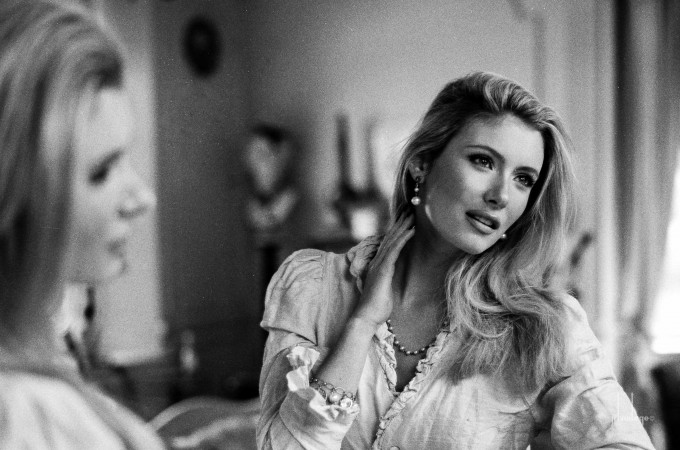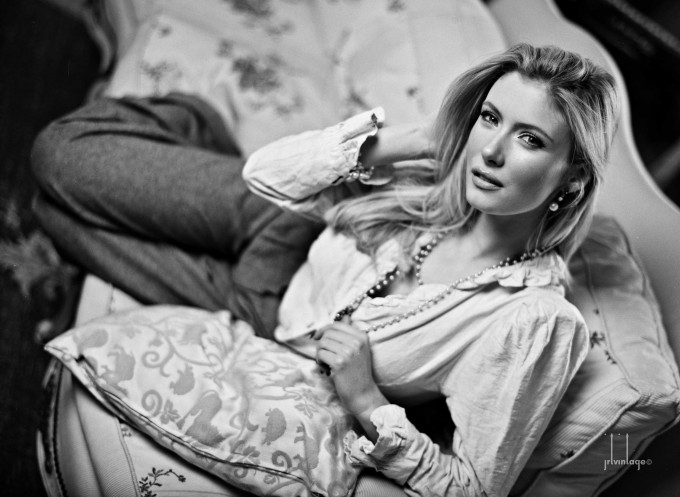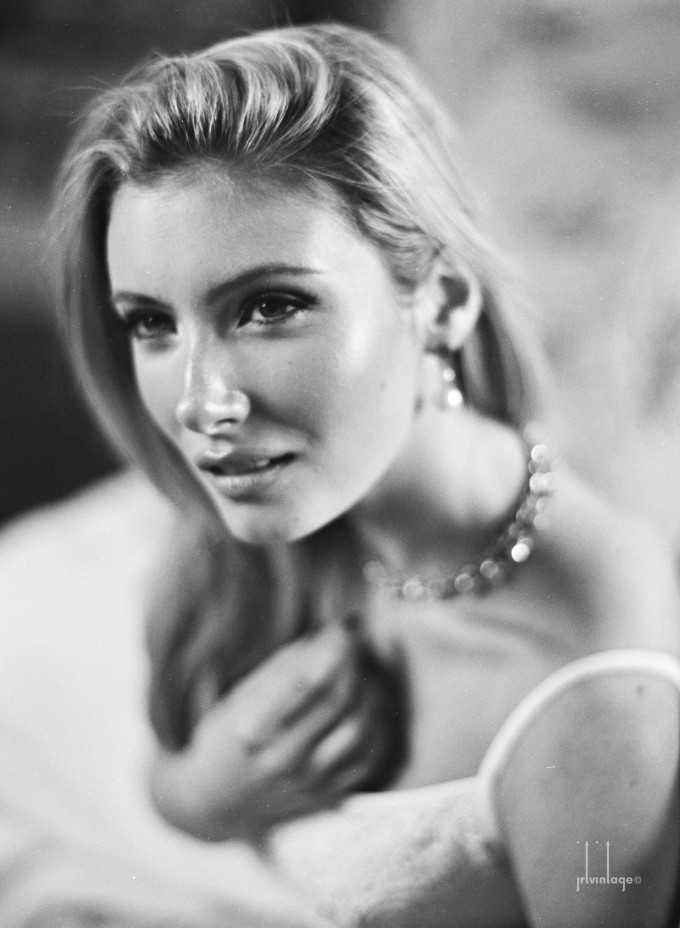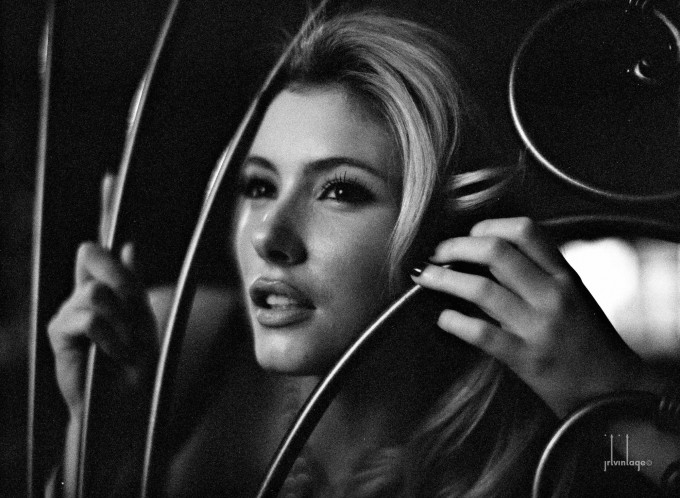Friday Film: Contax 645 and Leica M7
by John Tuckey
Hi All, another film Friday offering for you to love or hate as you like 😉 These images are all from a shoot last weekend. The key camera was the Leica Mono with the Noctilux, just back from being calibrated for optimum focus at minimum distance, I was keen to see if it would deliver the results, as I was starting to get a little frustrated with the beast.
However I also wanted to test out my new medium format joy toy (the Contax 645), and ideally get a comparison between the medium format monster and 35mm from my M7.
After a little musing I figured out that if I shot the Mono & Nocti at f1 and ISO 400 with a 3 stop ND grad, I’d be able to set the lights once and just jump the flash trigger onto the Contax at f2 with ISO 100 film, and the M7 with the 50’lux at f2 and ISO 50 film (M7 has a much slower flash sync speed) – score!
So, here’s a small selection for you. I’ll stress this isn’t meant to be a in-depth scientific comparison, it was a bit of fun while trying out new toys, and with over 90 frames to choose from this is a pretty eclectic mix! But it is interesting to see the difference in grain between the film formats even with the 35mm taken at a lower ISO. As someone said in a recent post ‘a good big’un beats a good little’un’!
Finally for those interested in comparing the Contax 645’s f2 DoF to the nocti at f1, the digital shots are here: http://500px.com/jrtbloke/sets/victoria_bond
Leica M7, 50mm Summilux ASPH @ f/2, 1/50, Ilford PanF ISO 50, Elinchrom flash
Leica M7, 50mm Summilux ASPH @ f/2, 1/50, Ilford PanF ISO 50, Elinchrom flash
Contax 645, 80mm f/2 @ f2, 1/125, Ilford Delta 100, Elinchrom flash
Contax 645, 80mm f/2 @ f2, 1/250, Ilford Pan-F 50, Elinchrom flash
Contax 645, 80mm f/2 @ f2, 1/125, Kodak Portra 400, just usign a modelling light in a soft box
Contax 645, 80mm f/2 @ f2, 1/125, Ilford Delta 400, natural light
Contax 645, 80mm f/2 @ f2, 1/125, Kodak Portra 400, natural light.
Contax 645, 80mm f/2 @ f2, 1/125, Ilford Delta 3200, natural light (or rather, lack of)
All the Best
John Tuckey












Hi John. I hope this comment finds you and you respond! I am getting into black and white film, and I do love the contrast and grain you are getting here, although I see in the comments that you have post processed these? Was this digital processing? I like some of the Ilford films but find them quite grey and flat, my style is a bit more low key and punchy. I’m not sure which films to pursue!…
For those complaining about the grain of the PanF 50, you should now that PanF 50 IS grainy. That’s a fact. If you want to have less grainy film shots, you should use Kodak T-max 100, Ilford Delta 100 or Adox CMS 20. This last film is amazing
Go medium format, go!
Impressive, exactly what I meant!
I’ll have a gander!
i find the noctilux or zeiss sonnar deliver what I want digitally with only 5 mins of adjusting levels, theres a link to the digital noctilux stuff on 500px at the top 😉
http://www.flickr.com/photos/66360321@N06/11755338886/in/set-72157628580833673
Due to some oversight a Jpeg (instead of a RAW) out of the D800 and 58/1.4, straight to b&w, minor tweaking.
Not really an equivalent model…
Ha ha; I find the “computer” quite restful, and quick as well, and not as smelly as a darkroom. I’m not likely, after thirty years or so, to get back to that!
Just to come back, a little late, on some other comments, I shoot film (next to the D800) as well on a regular basis (Michiel953 on Flickr) with my “old” Nikon slr’s and primes, don’t do my own processing, but have found a professional lab I can trust for developing, I know how they do it and can give instructions, and the shop I work through does the scanning (16base) really well. That has taken a load of my mind, as the unpredicatble results with other set-ups were really killing all the fun.
Back to digital: I would avoid heavy post processing; I hate that, and suffer from the conception that RAW out of camera should be near perfect, and should only require minor “tweaking”. Get rid of some blown highlights if any, adjust contrast a little, level a horizontal line if necessary, that’s it. No film simulating overlays for me.
The dreamy 50’s effect you sought so successfully should then be within reach (in a different, because digital, way) as well.
Tell me what you think!
I think the answer has to be out of camera, no. with enough post process yes – certainly close enough that no one would really care. I’d rather spend more time shooting the film than spend the extra time in front of the computer 😉
Very interesting shots John, and well done and explained too. For comparison’s sake (purely 😉 ) I would have liked to see shots made with a high Mp digital camera (D800, A7r) and dedicated portrait lens (58/1.4, an old one). Just RAWS converted straight to b&w, no filters or layers to bury the true character of camera and lens. Would you have been able to get close to that same look?
Stop apologizing Terry; no need at all.
Hi, Karl.
“Is not just fun to control everything, to create your own standard!”
I absolutely agree. For those of us brought up on film and film processing as part of our bread and butter, this was part of the fun and something that digital post processing can’t compete with. Well, this is my opinion.
Perhaps because of our generally cooler climate, UK film development was standardised on 68F/20C, although naturally the developer manufacturers published data for alternative temperature processing, especially in hotter climes where it would prove difficult to keep the temperature down to 20C.
Yes yes. But I learned tons of years ago, that some of my grain would look better, if all temps of all the baths were the same, dev, stop, fix and wash. The closer you got yo wash the less the damage. So if you dev. at 76 F, your stop should be 76 F and so on. I would use 3 to 1 Acufine, I think it was at 72 F.
Is not just fun to control everything, to create your own standard!
Stunning, John.
Very impressed.
Never can understand why people have to moan and bitch..
Just view the images, and enjoy.
Simple.
Like me..x
Cheers Gent, a much appreciated compliment 🙂
Outstanding work John. It’s so nice to see some beauty work that isn’t very manipulated in digital and I personally love the tonal gradations and draw that only these lenses on film can provide. For someone who has only been doing this for two years, you have some serious talent. I’ve been a pro for 25 and would be quite happy if these were mine. All this usual bull$&$& about grain and scans is nonsense and matters not to the quality. What matters here is your lighting, composition, DOF and the like is masterful. Kudos.
Beautiful set with lovely lighting and tone.
The Contax 645 is simply Great and I mean that! And blows away any digital or 35mm sized format.
I do agree with the views about the Pan F.
You need to use a better looking model… 🙂
Stunning…
Gorgeous model John! The first two shots are simply killer shots. Words can’t describe the impact of the atmosphere and her beauty.
Cheers Kevin. The Monochrom Shots where the reason we where all there of course, the film shots where a fun aside. Personally I love the glow that the nocti throws out wide open, to my eye it gives a fantastic retro feel to the frame… which is like a drug for the kind of shots I like to set up! Even stopped down it also softens the mono’s ‘super sharpness’ very nicely. For the same reasons I also find the sonnar and summitar are also nice lenses on the mono, but i find the 50 lux ASPH too sharp – its just really cruel to skin.
It’s just a shame that the nocti is such a pig to focus f1 at min distance. Getting Leica to calibrate it has made a *big* difference, but its still tough to nail. Interestingly my keeper rate with the calibrated nocti and mono was still higher than with the SLR Contax at f2 – perhaps thats just life wide open! 😉
Simply stunning! The look of film *gasp*!. Beautiful model, composition, choice of DOF and lighting…wow!
Excellent images. Cheers!
(I still dream of the Contax 645. If only it wasn’t so expensive.)
Meeeow, Doug. This is a photography website and not the letters section of Cosmo.
Stunning. Picture 7 does it for me. Thanks for sharing.
I can’t believe people are complaining about the film, processing and the model’s lips. Just incredible.
These are stunning images that *most* photographers would be very proud to have taken. Makes the case for film and MF… you just can’t achieve this look with micro four thirds and VSCO! Ha ha! 😉
Nice set – but the shots from the Monochrom (from your link) are outstanding – I even prefer them over the Contax! I think the Noctilux made them achieve a mix of medium format look with incredible tonality. Agree with Robert Falconer’s comments too.
Hi, John.
I suppose a lesson here, if there is on, is no one will take as good care of your film as you.
Perceptol is a great choice if you are going to use a wide range of Ilford film types. It is as equally suited to producing the fine grain inherent in their slow films and for use in the super fast ones as well.
If you are not that keen on mixing powder developers, one shot liquid developers make the job easier and as you use one shot and throw away it is possible for greater consistency. By no means the only one, I got excellent results with Pan F, FP4 and Kodak’s Tri-X using Aculux. But I also got great punchy negs, when needed, especially with Tri-X up to 5×4 sheet film, using D76.
The thing is with film/developer combinations is to experiment to find the combo that gives you the neg you want. But the first step should be to develop to a “standard” gamma first so you can get a feel for what the film was designed to reveal used optimally. Use this as a reference point and only then experiment This way you can assess by how much you are deviating from the optimum, and thus get repeatable results.
Hi Terry, I didn’t do the dev on this batch. With B&W I usually do it myself, but I had such a pile of 120 to do that i just decided to throw the lot at the local lab to dev and scan. My other consideration here was that as I have a dog but don’t have a dedicated dark room when i develop myself i suffer badly with dust, which I also hoped to avoid. That backfired a bit as theres still plenty of dust in the scans that have come back 🙁 I’ll do some PanF and DIY it with Ilford perceptol at end of month, will be intersesting to see how it differs from what the labs sent back 😉
John,
I’m surprised to read that you find Pan F a little too low in contrast for your needs. Films can be developed to different gammas and this will be covered in the developer manufacturer’s leaflet, and indeed by Ilford itself if you use an Ilford developer, such as ID 11. Kodak D76 is the same developer and is much cheaper, so you can happily substitute this.
Out of interest, what developer did you use?
Fantastic shots! I can totally see my Gear Aquisition Syndrome moving in the direction of medium format film next thanks to shots like these 🙂
i loved this set.
She is indeed, UK based photographers can look her up at purpleport.
Ah, but I’ve only been a photographer for 2 years and shooting film for 1 😉 The choice of PanF here was more to do with getting my exposure values in line across three cameras while hot swapping a flash without stopping to remeter at every switch, and it did the job. I think for me OOC delta 100 on 35mm and 100 or 400 on Medium format is the look i’m after, I found the PanF to be a little too low in contrast for my tastes – a stock to keep around for specific purposes maybe, it might do well for some sixties style shots i have planned at months end 🙂
Hi, Karl.
Of course, all of what you say, and one mustn’t overlook also exposure: underexpose and grain can be reduced, overexpose and it will be increased.
I think it goes without saying that to get the best “standardised” negative i.e. one which gives a combination of optimum overall grain, sharpness, and tonal range, it is best to follow the developer manufacturer’s instructions initially. After all, it is they who will have carried out quite searching tests on the various film/developer combinations. Then once one is satisfied how to get the best from a film/developer combination, and thus how the film performs to its designed criteria, then one can experiment to one’s heart’s content.
Hi, Thomas,
The reference to the grain needs to be seen in context: properly exposed and developed Pan F doesn’t exhibit this level of grain, hence why I queried with John if his captions were correct, especially as I could see the grain from the Very slow Pan F was more noticeable than that shot with a very fast, 3200 ISO, film. This explains why I initially thought his captions had got mixed up.
John has answered my query, and this explains the excessive and unexpected grain I can see from such a slow film as Pan F. This is not to decry the images; it was a technical issue solely related to the film.
@ Pi.
You will read that I was not criticising the images per se, but I was querying the coarse grain which I would not have expected to see from a properly developed Pan F film. John has responded explaining what he was trying to achieve. This is not a process I would use Pan F for, and align with padraigm here. But it is not to say one shouldn’t experiment to achieve a result that pleases oneself. Except for when I was having to meet a client’s specific needs, this is after all, all that my hobby is for me. If friends say they like an image, well it is welcoming to hear, but my work is solely to please me. I do not actively seek the approbation of others; this is not important to me.
Also, you will no doubt note in my acknowledgement to John, that I have been there, seen it, and done it for getting on for 44 years before I went mainly digital in 2003. I still do “keep my hand in” so to speak and enjoy my M6 and R7 and Rolleiflex 3.5f when the mood takes me. But purely for convenience I mainly use digital now.
Hi, John.
Thanks for the update. You’ve hit the nail on the head when you said the grain is not what I would have expected (from Pan F) but is your deliberate choice. It is a film I have experience of but invariably used it for its intended purpose: sharpness and fine grain.
I got into b/w film photography in 1959 and doing my own processing and printing and over the years developed experience in all formats from 16mm sub-min through to my 5×4 cameras. In those days with 35mm negs requiring so much enlarging for even a decent 10×8 print, developing for the finest grain and widest tonal range from any given film tended to be the norm. Film grain was something that generally was best avoided and was more of an accepted by product of using fast films. But then, if you’ve been into film since before digital, you will doubtless already know this.
I’m not fond of model picturing (that’s not my thing) but your work is really great and the processing quite wonderful…. Well done !
I’m guessing she is a professional model ? I like No 1 shot the best.. very natural and not cropped too close
After reading your text and the other comments. If you are developing your own B&W negs., one thing that will give clumps of grain and extra grain is temp. of all the baths. The developer, stop and fix, even wash should be the same. If you are doing this I am sorry for telling something you may already know. I found it to one of the most important parts in development.
Wow! Beautiful images. Great model with excellent facial expression too! The last 4 images are some of the best I’ve seen here.
I am surprised by how much better the 645 looks compared to 35mm at the same ISO. And as someone wrote above, monochrome film (especially medium format) still has much better tonality than digital.
Great composition, a celebration of femininity, beauty and style, most enjoyable work, thanks.
I like the fifth one the most. All this talk about grain…. I did not even notice it until it was mentioned. I suppose it is harsh if you’re looking for it, but it did not distract me from the beauty of the images and the model.
Beautiful.
I really enjoyed looking at those lovely, elegant photos. The model, the pose, the lighting…superb.
Different cause, same effect.
No not joking. Yes it is subjective I agree with what you said. But trying to make pan -f look like a “sorta”400 speed film is a strange choice. The whole point of shooting a film like pan-f is to get a certain look. Yes you can modify that etc.. but when you modify to the point of it completely doing away with any of the advantages a certain film has and it just ends trying to look like something its not then I question…Yes Pi if you put it under the banner of Art it can be anything. But he stated it was a comparison between MF and 35mm so I stand by my comment. Making a low speed 35 film look like a high speed film and then try to compare to MF is hardly valid. Other than that I love the pictures
Nice photos although it seems that something does not fit with Ilford Pan F. Anyway.
I should point out the low quality of the scans. Unfortunately are full of dust, are of low resolution and they do not make your photos any favour. Good film captures like yours need the best suitable scanning. Please do not oversee it otherwise your effort and skills will be in vain.
Best regards,
Dimitris V. Georgopoulos
Photographer at Large
Athens, Greece.
I like all of them, but the 5th shot is wonderful, one of the best portraits I have seen in this site!
I had a Contax 645, to me it was the best medium format camera I ever owned. I liked it more then Hassi.. It so sad they went out of biz. They made really nice 35mm cameras too.
Ah, not so Doug! its all in the makeup, she knows how to do proper lining Dietrich style just as I asked 😉
Hi padraigm, please excuse a C&P of my reply to Terry, but you both asked the same question 😉 The captions are correct. The grain is always there, its just lower contrast OOC, and my post process has thrown it up as I’ve adjusted. Here’s some links to the OOC files perhaps this is more what you expected. http://download.jrtvintage.co.uk/jrt_vic_film_undev-1.jpg and http://download.jrtvintage.co.uk/jrt_vic_film_undev-2.jpg
Hi Terry, the captions are correct. The grain is always there, its just lower contrast OOC, and my post process has thrown it up as I’ve adjusted. Here’s some links to the OOC files perhaps this is more what you expected. http://download.jrtvintage.co.uk/jrt_vic_film_undev-1.jpg and http://download.jrtvintage.co.uk/jrt_vic_film_undev-2.jpg
You 2 are joking right, if you you want sterile lifeless pics stick with your digital. If you want the magic of film you pull, push, change your development times and experiment with film types speeds and grain, then you produce wonderful images like these, film is art and very subjective. Very surprised at critism of these images.
Wow! Very nice and very interesting: film grain still is superior!
Really wonderful portraits, John.
Technically, these images also drive home two points when it comes to the difference between film and digital:
1. How much better film still is at tonality transitions from shadows to highlights (far more gradations are present)
2. How digital has now easily bested film when it comes to “noise” (grain) and ultimate acuity.
Very nice photos, but your model really should ease up on the collagen injections. Balloon lips.
I agree with Neil. These are beautiful shots. May have been easier using a flash meter, but then it all turned out well in the end.
TerryB beat me too it.. I totally agree. Search flickr and you can clearly see this is not indicative of what you can expect from this film even if you used rodinal.
Very nice. That’s a lot of grain for pan-F though even if it is 35mm. Are you sure its processed correctly?
John,
Are the captions to your images correct? The grain from you Pan F 35mm negs is horrendous, particularly the first, and appears stronger than that in your last image using Delta 3200. Clearly not what I would expect from such a slow speed film. I’m curious as to what developer you used as it doesn’t seem to be doing your images justice.
Beautiful!!!!! The photos and the woman!!
That works for me…
gorgeous!